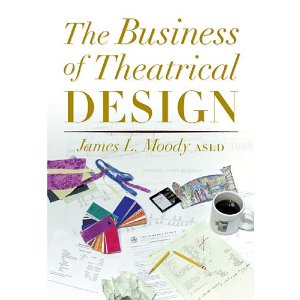
This is the story of The Business of Theatrical Design, by James L. Moody.
Does this book have anything to do with props people? Sure. Though it is geared towards the theatrical designers, both prop masters and artisans working in the freelance world need the advice and information presented within. Further, the job title of “properties designer” is becoming more prevalent in today’s theatrical world.
The first six chapters are on the technical aspects of running a business: accounting, staffing, offices, etc. A lot of this seems out of the realm of the average freelance props person. On the other hand, you will probably need some of the information at least once in your career. Even if you never have a full-time staff (very few freelance prop masters do), you will on occasion have an assistant or need to hire some outside help for some jobs. You may think you do not need an office, but if you have a shop, it might serve the same purpose. The information presented in these chapters is dense, and not meant to be read all at once in one sitting. Rather, it is a great reference to keep close by and refer to as needed.
Perhaps the only main deviation between the business of a theatrical designer and a props artisan is that theatrical design is mostly a service industry (according to Moody) while a props artisan mixes elements of manufacturing and service.
The next few chapters feel more directly applicable to the props freelancer. It deals with marketing yourself, networking, job interviews and dressing for success. Sure, you can find this kind of information elsewhere, but most of it seems geared towards bankers and mid-level managers applying for cattle calls at large corporations. This book deals with all the quirks and idiosyncrasies of getting jobs in the world of theatre and entertainment design. It also devotes some time to dealing with the aspects of the job not typically covered in other books about theatre work, such as conflict resolution and group dynamics.
This book does have a few flaws. It is fairly US-centric when dealing with specifics about legal topics, business culture, contracts and unions. Though only written in 2002, it is a touch outdated when it comes to technology and the internet; I don’t think I would suggest to anyone to carry around a CD of your work, especially when thumb drives and jump drives can hold so much more information in a much smaller space and work on nearly every computer (some newer laptops and tablets don’t even come with a CD drive). I also think an internet presence is more of a necessity these days. Employers are incredibly likely to run an internet search on you when you are applying for a job or a gig; even if you do not have a website, you should run an internet search on yourself to see what they would see.
This book fills the gaps in theatre education for the all important considerations of the business side of show business. Maybe your education did not give you the chance to take business classes while enrolled, or maybe you did not find yourself working as a professional freelancer until well after your formal education ended. In any case, The Business of Theatrical Design covers such a broad range of information not found elsewhere that makes this a must-have for anyone wanting to make a living in theatre.




